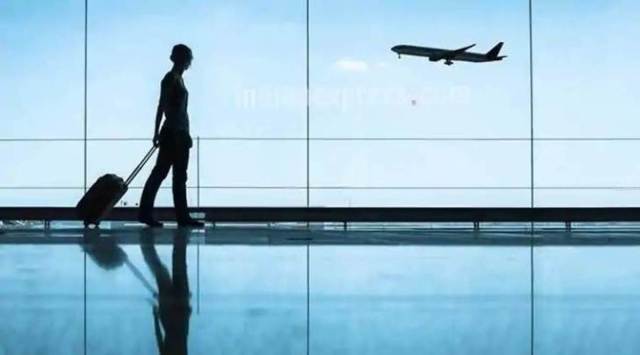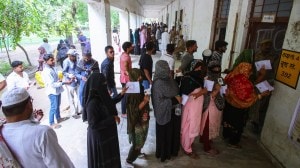- India
- International
Railways limping, swift growth in non-metro flights; Patna recovery fastest in October
The main reason for smaller cities showing faster air traffic growth is the continued curtailment of railway operations in many parts of the country, those tracking the sector said.
 Along with the limits on airfares, the government had asked the airlines to operate not more than 33 per cent of their pre-COVID domestic flights. (Representational)
Along with the limits on airfares, the government had asked the airlines to operate not more than 33 per cent of their pre-COVID domestic flights. (Representational)Patna, Guwahati, Varanasi, Srinagar — flights to and out of non-metro and tier-1 cities have been among the fastest growing passenger traffic routes since domestic civil aviation reopened up on May 25 after two months of lockdown-enforced closure.
There are two clear takeaways from the data. One, routes such as Delhi-Patna, Delhi-Srinagar, and Delhi-Guwahati have replaced routes such as Kolkata-Delhi, Mumbai-Hyderabad, and Bengaluru-Hyderabad in the top 10 list of domestic air routes by numbers of seats allocated by airlines this month so far. Two, in terms of actual domestic passenger numbers for October, Patna, Srinagar, and Varanasi operated at over 60 per cent that of October 2019.
The main reason for smaller cities showing faster air traffic growth is the continued curtailment of railway operations in many parts of the country, those tracking the sector said. For places like Patna and Srinagar, there are specific additional reasons such as election-related travel and the liberal arrival policy in the region.
The Delhi-Patna route has seen higher capacity allocation by airlines than some of the traditional trunk routes this month. There were 1.79 lakh seats flying between the two airports in November, making it the fourth busiest route in India currently. In comparison, there were 1.69 lakh seats between Delhi and Hyderabad, 1.61 lakh on Bengaluru-Mumbai, and 1.03 lakh on Mumbai-Hyderabad.
“While the demand in the last few months was on account of the Bihar Assembly elections, movement of labour has been high on this sector,” a senior executive at a low-cost airline said, adding, “A part of this demand would have usually been absorbed by the railways but trains are not running at peak frequency across India yet.”

Compared with the pre-Covid situation, Patna recorded the best numbers in October. As per data from aviation analysis platform NetworkThoughts, domestic passenger traffic in October at Patna airport was almost 80 per cent of that month last year. The numbers for Srinagar and Varanasi were around 67 per cent and 65 per cent of the corresponding numbers for 2019, respectively.
“Traffic at smaller airports is mainly driven by the regional connectivity (UDAN) scheme. Also, in percentage terms, traffic was at a low base (in smaller towns) and therefore, it was easier to achieve pre-Covid levels,” Ameya Joshi of NetworkThoughts said. According to data from British aviation consultancy OAG, the number of seats allocated to the two busiest routes in India — Delhi-Mumbai and Bengaluru-Delhi — this November have been almost half of that in November last year. The Bengaluru-Mumbai route, the third busiest last year, has been replaced by Bengaluru-Kolkata this year.
The reason for the Mumbai routes falling out of the top 10 list is the restrictions imposed by the state government. Currently, only 100 arrivals and 100 departures a day are allowed at Mumbai, the country’s second busiest airport. These numbers are double the 50 arrivals and 50 departures allowed after operations resumed post-lockdown, but still only a fifth of the airport’s capacity.
Overall, the Centre has restricted the number of domestic flights to 70 per cent of the pre-Covid level. The cap on capacity was 33 per cent in May and has been gradually lifted; a relaxation from 60 per cent to 70 per cent was announced on November 12. However, the OAG data show the capacity allocated by airlines for November was 62 per cent of November 2019.
Airline industry professionals expect an uptick in demand led by tourists and those visiting friends and relatives, but remain pessimistic on business travel. Travel agents have pointed to tourism as the main reason for the rise in demand for travel to Srinagar. At 1.57 lakh seats in November, the Delhi-Srinagar route was the country’s seventh busiest. In fact, deviating from the general trend, seat allocation for Delhi-Srinagar has actually been higher than the 1.27 lakh of November 2019.
“In the last 2-3 months, Jammu & Kashmir’s tourism secretary Sarmad Hafeez and director, tourism, Nisar Ahmad Wani got in touch with a lot of travel agents and made sure that the arrival policy is very liberal. Another draw for tourists has been cultural programmes — they have finished one in Gulmarg and are planning another in Pahalgam,” Sanjay Narula, MD of the Delhi-based Apex Travels & Tours and former vice-president of Travel Agents Association of India, said.”Along with all this, air fares to Kashmir have been very cheap. People starved of travel also perceive Kashmir as a place where spread of Covid is not extensive,” he added.
As caseloads increase and several states begin to issue fresh restrictions, however, airlines are taking a relook at their strategy. “With increasing hope of vaccines being available early in the new year, there should be a recovery in demand, and there is plenty of available capacity … Airlines and airports have taken all possible steps to ensure that travel is safe, and as confidence builds so will demand,” Mayur Patel, head of Japan and Asia Pacific at OAG Aviation, said.
Apr 26: Latest News
- 01
- 02
- 03
- 04
- 05








































